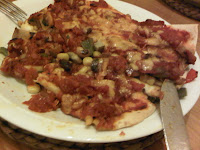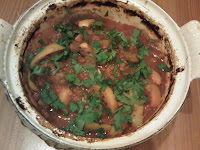 Edible presents are the best - suitably frugal for the purposes of this blog, and the pocket. These bikkies are lovely and spicy. If you want to make them into hanging tree decorations, cut a hole for a ribbon with a piping bag nozzle from the soft cookies as soon as they come out of the oven. Once cool, ice them with a not too runny icing made from icing sugar and boiling water, and decorate with edible glitter. But personally I like them just as they are...
Edible presents are the best - suitably frugal for the purposes of this blog, and the pocket. These bikkies are lovely and spicy. If you want to make them into hanging tree decorations, cut a hole for a ribbon with a piping bag nozzle from the soft cookies as soon as they come out of the oven. Once cool, ice them with a not too runny icing made from icing sugar and boiling water, and decorate with edible glitter. But personally I like them just as they are...Ingredients
- 200g plain flour
- 1 tsp baking powder
- 2 tsp ground ginger (use a good one, like Barts Spices)
- 1 tsp ground cinnamon
- 1/4 tsp ground cloves
- 1/4 tsp freshly ground black pepper
- 75g unsalted butter
- 75g golden caster sugar
- 3 generous tablespoons golden syrup
Method
- Pre-heat the oven to 180C/350F. Line a baking sheet with greaseproof paper.
- Put the butter, sugar and golden syrup in a saucepan over gentle heat and melt together.
- Whilst they melt, sieve the flour, baking powder, and spices into a mixing bowl. Grind in the pepper.
- When the butter and sugar mix is runny add to the flour and beat in thoroughly. You may need to add a little milk to make the dough sticky enough, but it is a crumbly mix.
- Gently kneed the dough together, it may keep falling apart in an annoying way, stay with it.
- Once all the biscuit dough is together, start to roll it out on a lightly floured surface. Don't try and move it around, it won't stick to the surface.
- When you have it rolled to 1/2cm thickness (no less), dip the cutters in flour and cut your biscuits. The dough will take a lot of squidging together and re-rolling, don't be timid. Use a pallet knife to move the cookies to the tray so they don't collapse.
- Bake the biscuits for 6 minutes until golden round the edges. Don't overcook, they will harden on the tray. Leave to cool and snaffle..






 ase let me apologise for my unscheduled absence of 2 weeks and counting. I never meant to let my posts lapse to this extent, but starting some part-time voluntary work has rather knocked me for six over the last couple of weeks, and my cooking has likewise suffered*. I had a baked potato and cheese for supper tonight...
ase let me apologise for my unscheduled absence of 2 weeks and counting. I never meant to let my posts lapse to this extent, but starting some part-time voluntary work has rather knocked me for six over the last couple of weeks, and my cooking has likewise suffered*. I had a baked potato and cheese for supper tonight...









